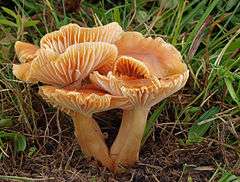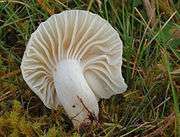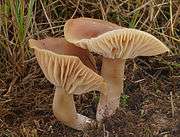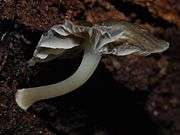Cuphophyllus
Cuphophyllus is a genus of agaric fungi in the family Hygrophoraceae. Cuphophyllus species belong to a group known as waxcaps in English, sometimes also waxy caps in North America or waxgills in New Zealand. The genus was described by French mycologist Marcel Bon in 1985.[1] It is synonymized with Hygrocybe by some authorities,[2][3] although recent molecular evidence confirms its validity as a distinct genus.[4]
| Cuphophyllus | |
|---|---|
 | |
| Cuphophyllus pratensis | |
| Scientific classification | |
| Kingdom: | |
| Division: | |
| Class: | |
| Order: | |
| Family: | |
| Genus: | Cuphophyllus |
| Type species | |
| Cuphophyllus pratensis (Pers.) Bon (1985) | |
Taxonomy
History
Cuphophyllus species have sometimes been referred to the genus Camarophyllus (Fr.) P.Kumm., but, as argued by Donk (1962), the type species of Camarophyllus must be Agaricus camarophyllus Alb. & Schwein. the species from which the genus takes its name.[5] This means that Camarophyllus sensu stricto is a synonym of Hygrophorus, since A. camarophyllus is a Hygrophorus species (Hygrophorus camarophyllus). This is now accepted by all standard authorities.[6][7][3] Singer (1951), however, proposed Agaricus pratensis (= Cuphophyllus pratensis) as the type species of Camarophyllus,[8] which means that Camarophyllus sensu Singer is a synonym of Cuphophyllus.
Current status
Recent molecular research, based on cladistic analysis of DNA sequences, suggests that Cuphophyllus is monophyletic and forms a natural group distinct from Hygrocybe sensu stricto.[9][10] It is therefore likely to be adopted more widely in the near future, as noted in the most recent (2010) European guide to waxcaps.[3]
Description
Species are distinguished from most other waxcaps by producing basidiocarps (fruit bodies) with strongly decurrent lamellae (gills).
Economic usage
Fruit bodies of one of the commoner European waxcap species, C. pratensis, are edible[3] and widely collected, sometimes being offered for sale in local markets.
Species
- C. acutoides
- C. adonis
- C. albidocinereus
- C. angustifolius
- C. antillanus
- C. aurantius
- C. basidiosus
- C. berkeleyi
- C. bicolor
- C. borealis
- C. buccinulus
- C. canescens
- C. cereopallidus
- C. cinerellus
- C. cinereus
- C. citrinopallidus
- C. colemannianus
- C. flavipes
- C. fornicatus
- C. fuscensis
- C. griseorufescens
- C. grossulus
- C. hygrocyboides
- C. lacmus
- C. lilacinus
- C. nebularis
- C. neopratensis
- C. niveicolor
- C. neopratensis
- C. ochraceopallidus
- C. pegleri
- C. pratensis
- C. radiatus
- C. rigelliae
- C. russocoriaceus
- C. subradiatus
- C. subviolaceus
- C. umbrinus
- C. virgineus
- C. viola
- C. xanthochrous

Cuphophyllus virgineus 
Cuphophyllus colemannianus 
Camarophyllus griseorufescens
See also
References
- "Cuphophyllus (Donk) Bon". Index Fungorum. CAB International. Retrieved 2011-12-29.
- "Cuphophyllus (Donk) Bon". MycoBank. International Mycological Association. Retrieved 2011-12-29.
- Boertmann D. (2010). The genus Hygrocybe (2nd ed.). Copenhagen: Danish Mycological Society. p. 200. ISBN 978-87-983581-7-6.
- Lodge DJ, Padamsee M, Matheny PB, Aime MC, Cantrell SA, Boertmann D, et al. (2014). "Molecular phylogeny, morphology, pigment chemistry and ecology in Hygrophoraceae (Agaricales)". Fungal Diversity. 64 (1): 1–99. doi:10.1007/s13225-013-0259-0.
- Donk MA (1962). "The generic names proposed for the Agaricaceae". Beihefte zur Nova Hedwigia. 5: 1–320.
- "Camarophyllus (Fr.) P. Kumm". Index Fungorum. CAB International. Retrieved 2011-12-29.
- "Camarophyllus (Fr.) P. Kumm". MycoBank. International Mycological Association. Retrieved 2011-12-29.
- Singer R. (1949). "The Agaricales in modern taxonomy". Lilloa. 22: 1–832.
- Matheny PB, Curtis JM, Hofstetter V, Aime MC, Moncalvo JM, Ge ZW, Slot JC, Ammirati JF, Baroni TJ, Bougher NL, Hughes KW, Lodge DJ, Kerrigan RW, Seidl MT, Aanen DK, DeNitis M, Daniele GM, Desjardin DE, Kropp BR, Norvell LL, Parker A, Vellinga EC, Vilgalys R, Hibbett DS (2006). "Major clades of Agaricales: a multilocus phylogenetic overview" (PDF). Mycologia. 98 (6): 982–95. doi:10.3852/mycologia.98.6.982. PMID 17486974. Archived from the original (PDF) on 2016-03-03.
- Babos M, Halász K, Zagyva T, Zöld-Balogh Á, Szegő D, Bratek Z (2011). "Preliminary notes on dual relevance of ITS sequences and pigments in Hygrocybe taxonomy". Persoonia. 26: 99–107. doi:10.3767/003158511X578349. PMC 3160800. PMID 22025807.